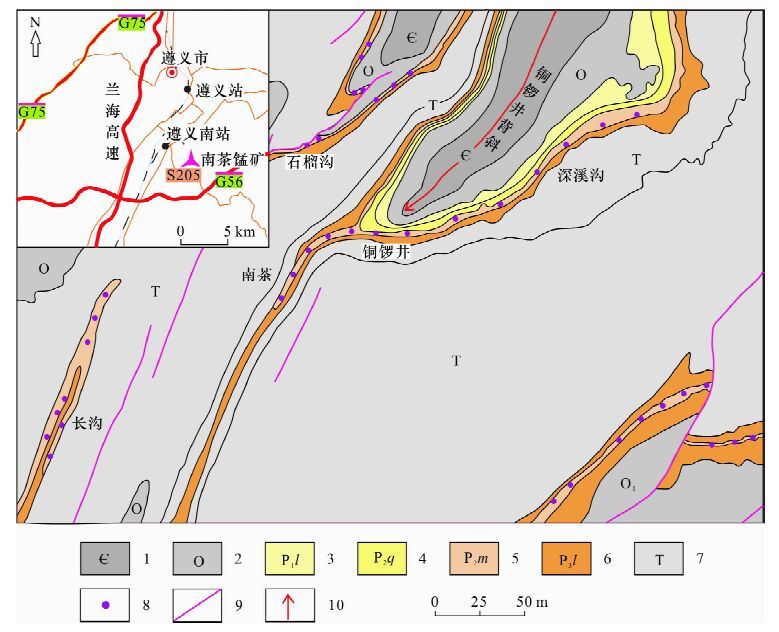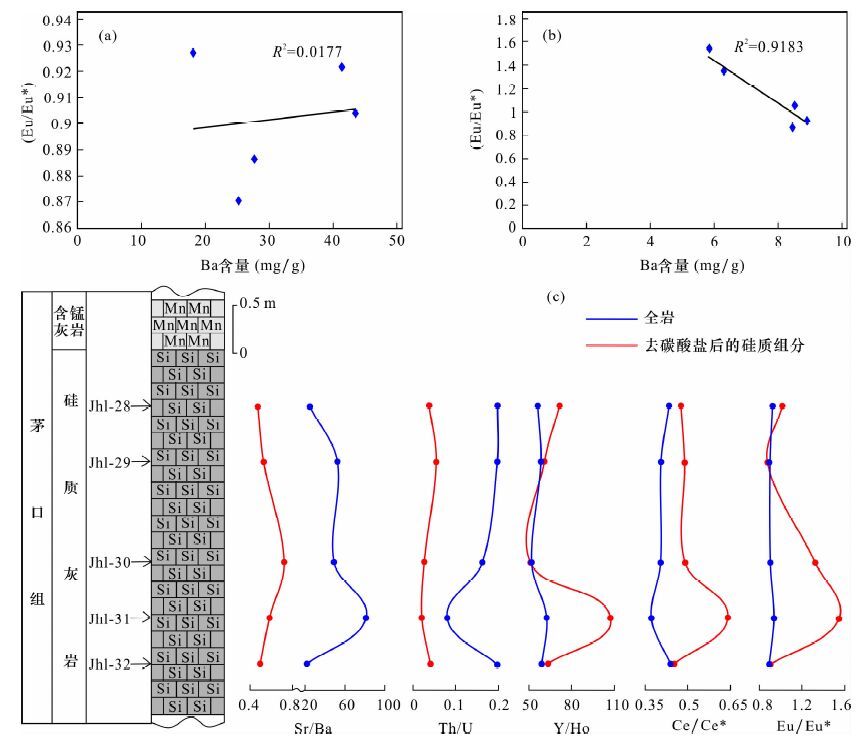Application of the Removing Carbonate Method to Study the Origin of Silica in ‘Bainitangceng’ of Yunnan-Guizhou Area
-
摘要: 滇黔地区的"白泥塘层"与锰矿具有密切的成因联系,前人对其地球化学特征研究时关注的主要是硅质灰岩全岩,并非硅质成分本身,而硅质岩全岩能否真实地反映"白泥塘层"中硅质的来源有待研究。本文以滇黔地区"白泥塘层"硅质灰岩为研究对象,用盐酸去除硅质灰岩中的碳酸盐矿物,获得成分较为单一的硅质组分,采用ICP-MS和ICP-OES测定全岩与去除碳酸盐的硅质组分中的微量元素,通过对比两者的微量元素地球化学特征研究"白泥塘层"中硅质的来源问题。结果表明:去除碳酸盐的硅质组分的Th/U=0.02~0.05,低于全岩的Th/U值(0.08~0.2),Eu/Eu*=0.86~1.54(均值1.15),显示为正Eu异常,此特征不同于全岩(全岩的Eu/Eu*=0.87~0.93,均值0.90,显示为弱的负Eu异常);硅质组分及全岩的稀土含量均表现为轻稀土较重稀土富集,但硅质组分中的轻稀土所占比重大于全岩。以上特征确切地表明了"白泥塘层"硅质灰岩中的硅质成分来自于热水,对于解释二叠系时期锰矿的形成具有重要的指示意义。
-
关键词:
- "白泥塘层" /
- 硅质组分 /
- 碳酸盐矿物 /
- 热水成因 /
- 电感耦合等离子体质谱/光谱法
Abstract: Bainitangceng in the Yunnan and Guizhou area has a close relationship with manganese deposits. Previous geochemical studies focused on the whole rock of siliceous limestones rather than siliceous components. The question of whether or not whole rocks can really reflect the source of siliceous components needs further study. In this study, Bainitangceng' siliceous limestone in Yunnan and Guizhou area was selected and HCl was used to remove the carbonate minerals in siliceous limestone to acquire simple composition siliceous components. Trace elements in siliceous components were determined by ICP-MS/OES. The origin of siliceous components is discussed by comparing the trace elemental composition of the whole rock of siliceous limestone and siliceous components after removing carbonate. Results show that Th/U ratios (0.02-0.05) in siliceous components are lower than those (0.08-0.2) of the whole rock of siliceous limestone. Siliceous components after removing the carbonate minerals have Eu/Eu* values of 0.86 to 1.54 with positive Eu anomaly, different from Eu/Eu* values (0.87-0.93) of the whole rock of siliceous limestone with negative Eu anomaly. Both whole rock of siliceous limestone and siliceous components are characterized by enriching the light rare earth elements, but the proportion of light rare earth elements in siliceous components is larger than that in whole rock. The above characteristics indicate that the siliceous component of ‘Bainitangceng’ may have been derived from hydrothermal fluid, which is important for explaining the formation of Permian manganese deposits. -

-
表 1 去除碳酸盐后硅质组分与全岩的微量元素(包括稀土元素)数据
Table 1. Trace elements data (including rare earth elements) in siliceous components removing carbonate minerals and total rock
微量元素 去除碳酸盐样品(×10-6) 未去除碳酸盐样品(×10-6) Jhl-28 Jhl-29 Jhl-30-2 Jhl-31 Jhl-32 Jhl-28 Jhl-29 Jhl-30 Jhl-31 Jhl-32 Ti 152.54 152.80 127.70 99.30 153.84 330.80 196.60 226.00 146.30 328.50 V 223.20 185.46 201.80 169.98 249.40 510.90 356.60 387.90 381.30 573.40 Cr 70.42 63.66 60.64 51.68 73.18 155.40 101.90 120.80 83.48 153.80 Co 1.97 1.87 1.35 0.95 2.28 5.76 4.10 3.85 2.73 6.58 Ni 23.74 21.72 17.14 13.02 26.98 61.26 41.09 45.56 29.14 69.60 Cu 5.70 4.38 3.60 2.03 6.14 11.06 4.80 5.79 1.13 12.88 Zn 46.98 116.74 50.88 65.42 59.56 109.70 163.90 91.01 110.90 128.30 Ga 0.81 0.82 0.64 0.58 0.85 2.62 1.89 1.52 1.26 3.22 Sr 3.94 4.37 4.56 3.45 4.48 914.90 1472.00 1274.00 1459.00 880.20 Zr 25.64 22.64 12.89 29.04 17.59 67.58 35.26 21.72 33.29 40.50 Mo 4.48 5.24 4.08 2.97 5.47 20.31 13.77 15.41 9.79 24.98 Ba 8.52 8.44 6.31 5.84 8.90 41.47 27.72 25.25 18.15 43.51 Th 0.06 0.08 0.06 0.02 0.07 1.81 1.20 1.17 0.40 1.95 U 1.53 1.73 1.89 5.56 8.08 8.92 5.99 6.79 5.26 9.88 Sr/Ba 0.46 0.52 0.72 0.59 0.50 22.06 53.10 50.46 80.39 20.23 Ni/Co 12.08 11.60 12.71 13.76 11.84 10.64 10.02 11.83 10.66 10.58 Th/U 0.04 0.05 0.03 0.02 0.04 0.20 0.20 0.17 0.08 0.20 V/Cr 3.17 2.91 3.33 3.29 3.41 3.29 3.50 3.21 4.57 3.73 V/(V+Ni) 0.90 0.90 0.92 0.93 0.90 0.89 0.90 0.89 0.93 0.89 La 1.03 0.94 0.59 0.24 1.49 25.97 22.75 17.57 15.34 27.45 Ce 0.72 0.77 0.43 0.24 0.94 20.92 15.91 12.65 9.958 21.72 Pr 0.09 0.13 0.06 0.03 0.12 4.797 4.103 3.066 2.529 4.969 Nd 0.28 0.46 0.17 0.11 0.34 16.98 13.53 10.22 8.466 17.08 Sm 0.04 0.07 0.02 0.01 0.05 3.56 2.855 2.136 1.662 3.718 Eu 0.0106 0.0128 0.0088 0.0056 0.0106 0.758 0.572 0.438 0.353 0.791 Gd 0.05 0.07 0.04 0.02 0.06 4.11 3.172 2.547 1.89 4.428 Tb 0.0072 0.0092 0.0064 0.003 0.008 0.438 0.328 0.252 0.192 0.449 Dy 0.06 0.07 0.06 0.02 0.07 3.126 2.403 1.834 1.421 3.335 Ho 0.0134 0.0166 0.0136 0.0048 0.0158 0.539 0.402 0.314 0.241 0.582 Er 0.05 0.05 0.04 0.01 0.06 1.419 1.09 0.844 0.624 1.56 Tm 0.0088 0.01 0.0096 0.0028 0.0114 0.211 0.156 0.124 0.094 0.232 Yb 0.06 0.07 0.06 0.02 0.08 1.259 0.958 0.721 0.56 1.441 Lu 0.0096 0.0126 0.0126 0.0038 0.0138 0.244 0.187 0.142 0.099 0.267 Y 0.97 1.01 0.70 0.52 0.94 29.44 23.29 16.46 14.18 32.42 ∑LREEs 2.18 2.38 1.28 0.64 2.95 72.99 59.72 46.08 38.31 75.73 ∑HREEs 0.25 0.31 0.24 0.09 0.31 11.35 8.70 6.78 5.12 12.29 ∑LREEs/∑HREEs 8.64 7.64 5.24 7.37 9.52 6.43 6.87 6.80 7.48 6.16 REEs+Y 17.01 18.48 11.16 6.23 20.99 113.77 91.71 69.32 57.61 120.44 Y/Ho 72.70 60.80 51.69 107.75 59.52 54.62 57.94 52.42 58.84 55.70 Pr/Pr* 1.24 1.31 1.32 1.05 1.25 1.42 1.55 1.51 1.53 1.45 Ce/Ce* 0.48 0.49 0.49 0.64 0.45 0.43 0.38 0.39 0.36 0.43 Eu/Eu* 1.05 0.86 1.35 1.54 0.92 0.92 0.89 0.87 0.93 0.90 -
[1] 贵州省地质矿产局编著.贵州省区域地质志[M].北京:地质出版社,1987:558-560.
Bureau of Geology and Mineral Resources of Guizhou Province.Regional Geology of Guizhou Province[M].Beijing:Geological Publishing House,1987:558-560.
[2] 刘巽锋,王庆生,高兴基等编著.贵州锰矿地质[M].贵阳:贵州人民出版社,1989:7-56.
Liu X F,Wang Q S,Gao X J,et al.Manganese Deposits of Guizhou[M].Guiyang:Guizhou People's Publishing House,1989:7-56.
[3] 陶平,杜昌乾,马荣,等.贵州及邻区二叠系锰矿地质特征及成矿作用探讨[J].贵州地质, 2005,22(2):102-108.
Tao P,Du C Q,Ma R,et al.The Research on Geologic Feature and Metallogenesis of the Permian Manganese Ore Deposits in Guizhou and the Vicinages[J].Guizhou Geology,2005,22(2):102-108.
[4] 林贵生,李赟.遵义锰矿地质特征及找矿潜力分析[J].中国锰业,2006,24(3):26-30.
Lin G S,Li Y.Geological Characteristics and Prospectives of Zunyi Manganese Ores[J].China's Manganese Industry,2006,24(3):26-30.
[5] 刘平,廖友常,殷科华,等.与火山活动有关的热水沉积锰矿——以贵州二叠纪锰矿为例[J].中国地质,2008,35(5):992-1006.
Liu P,Liao Y C,Yin K H,et al.Hydrothermal Sedimentary Deposits Associated to Volcanic Activities-Permian Manganese Deposit in Guizhou[J].Geology in China,2008,35(5):992-1006.
[6] 铁永洪,刘志臣,张远国,等.遵义锰矿地质特征及富集规律[J].矿业工程研究,2013,28(3):63-67.
Tie Y H,Liu Z C,Zhang Y G,et al.Geological Characteristics and Enrichment Regularity of Zunyi Manganese Ore[J].Mineral Engineering Research,2013,28(3):63-67.
[7] 刘志臣,张远国,陈登,等.贵州遵义锰矿区"白泥塘层"硅质岩地球化学特征及其地质意义[J].矿物学报,2013,33(4):665-670.
Liu Z C,Zhang Y G,Chen D,et al.Geochemical Characteristics and Geological Significance of ‘Bainitangceng’ Siliceous Rocks in Zunyi Manganese Ore Fields,Guizhou Province,China[J].Acta Mieralogica Sinica,2013,33(4):665-670.
[8] 杜小全.黔北二叠纪锰矿成矿条件与找矿方向[J].矿产勘查,2011,2(3):249-253.
Du X Q.Metallogenic Conditions and Prospecting Direction for Permian Manganess Deposit in Northern Guizhou[J].Mineral Exploration,2011,2(3):249-253.
[9] 皮道会,刘丛强,邓海琳,等.贵州遵义牛蹄塘组黑色岩系有机质的稀土元素地球化学研究[J].矿物学报,2008,28(3):303-310.
Pi D H,Liu C Q,Deng H L,et al.REE Geochemistry of Organic Matter from Black Shales of the Niutitang Formation,Zunyi,Guizhou Province[J].Acta Mineralogica Sinica,2008,28(3):303-310.
[10] 裴浩翔,付勇,徐志刚,等.贵州道坨锰矿菱锰矿的稀土元素特征[J].沉积与特提斯地质,2015,35(1):76-85.
Pei H X,Fu Y,Xu Z G,et al.REE Characteristics of Rhodochrosite from the Daotuo Manganese Deposit in Guizhou[J].Sedimentary Geology and Tethyan Geology,2015,35(1):76-85.
[11] 姚旭,周瑶琪,李素,等.硅质岩与二叠纪硅质沉积事件研究现状及进展[J].地球科学进展,2013,28(11):1189-1200.
Yao X,Zhou Y Q,Li S,et al.Research Status and Advances in Chert and Permian Chert Event[J].Advances in Earth Science,2013,28(11):1189-1200.
[12] Tribovillard N,Algeo T J,Lyons T,et al.Trace Metals as Paleoredox and Paleoproductivity Proxies:An Update[J].Chemical Geology,2006,232(1):12-32.
[13] Dypvik H.Geochemical Compositions and Depositional Conditions of Upper Jurassic and Lower Cretaceous Yorkshire Clays[J].England Geology,1984,121(5):489-504.
[14] Dill H.Metallogenesis of Early Palaeozoic Graptolite Shales from the Graefenthal Horst (Northern Bavaria-Federal Republic of Germany)[J].Economic Geology,1986,81:889-903.
[15] Liu K,Yang R D,Chen W Y,et al.Trace Element and REE Geochemistry of the Zhewang Gold Deposit,Southeastern Guizhou Province,China[J].Chinese Journal of Geochemistry,2014,33:109-118.
[16] Morford J L.Diagenesis of Oxyanions (V,U,Re,and Mo) in Pore Waters and Sediments from a Continental Margin[J].Geochimica et Cosmochimica Acta,2005,69(21):5021-5032.
[17] Kimura H,Watanabe Y.Oceanic Anoxia at the Precam-brian-Cambrian Boundary[J].Geology,2001,29(11):995-998.
[18] Wignall P B,Twitchett R J.Oceanic Anoxia and the End Permian Mass Extinction[J].Science,1996,272(5265):1155-1158.
[19] Rona P A.Criteria for Recognition of Hydrothermal Mineral Deposits in Ocean Crust[J].Economic Geology,1987,73:135-160.
[20] Owen A,Armstrong A H,Floyd D J.Rare Earth Element Geochemistry of Upper Ordovician Cherts from the Southern Uplands of Scotland[J].Journal of the Geological Society,1999,156(1):191-204.
[21] Chen D Z,Qing H R,Yan X,et al.Hydrothermal Venting and Basin Evolution (Devonian,South China):Constraints from Rare Earth Element Geochemistry of Chert[J].Sedimentary Geology,2006,183(3-4):203-216.
[22] Wang J G,Chen D Z,Wang D,et al.Petrology and Geochemistry of Chert on the Marginal Zone of Yangtze Platform,Western Hunan,South China,during the Ediacaran-Cambrian Transition[J].Sedimentary Geology,2012,59(3):809-829.
[23] Nozaki Y,Zhang J, Amakawa H,et al.The Fractionation between Y and Ho in the Marine Environment[J].Earth and Planetary Science Letters,1997,148(1-2):329-340.
[24] Dieudonne C I I, Cheo E H, Ghogomu R T.Textures and Rare Earth Elements Composition of Banded Iron Formations at Njweng Prospect,Mbalam Iron Ore District,Southern Cameroon[J].International Journal of Geosciences,2013,4:146-165.
[25] Lawrence M G,Kamber B S.The Behaviour of the Rare Earth Elements during Estuarine Mixing-revisited[J].Marine Chemistry,2006,100(1):147-161.
[26] Chen L,Lin A T S,Da X J,et al.Sea-level Changes Recorded by Cerium Anomalies in the Late Jurassic (Tithonian) Black Rock Series of Qiangtang Basin,North-Central Tibe[J].Oil Shale,2012,29(1):18-35.
[27] German C R,Elderfield H.Application of the Ce Anomaly as a Paleoredox Indicator:The Ground Rules[J].Paleoceanography,1990,5(5):823-833.
[28] Kamber B S,Webb G E.The Geochemistry of Late Archaean Microbial Carbonate:Implications for Ocean Chemistry and Continental Erosion History[J].Geochimica et Cosmochimica Acta,2001,65(15):2509-2525.
[29] Bolhar R,Van Kranendonk M J.A Non-marine Deposi-tional Setting for the Northern Fortescue Group,Pilbara Craton,Inferred from Trace Element Geochemistry of Stromatolitic Carbonates[J]. Precambrian Research,2007,155(3-4):229-250.
[30] Jeans C V,Wray D S,Williams C T,et al.Redox Conditions in the Late Cretaceous Chalk Sea:The Possible Use of Cerium Anomalies as Palaeoredox Indicators in the Cenomanian and Turonian Chalk of England[J].Acta Geologica Polonica,2015,65(3):345-366.
[31] Murray R W,Brink M R B,Jones D L,et al.Rare Earth Elements as Indicators of Different Marine Depositional Environment in Chert and Shale[J].Geology,1990,18(3):268-271.
[32] Dulski P.Interferences of Oxide,Hydroxide and Chloride Analyte Species in the Determination of Rare Earth Elements in Geological Samples by Inductively Coupled Plasma-Mass Spectrometry[J].Fresenius' Journal of Analytical Chemistry,1994,350(4):194-203.
[33] Anja G,Dirk M,Georg B.Origin of Middle Rare Earth Element Enrichment in Acid Mine Drainage-impacted Areas[J].Environmental Science and Pollution Research,2014,21:6812-6823.
[34] Dubinin A.Geochemistry of Rare Earth Elements in the Ocean[J].Lithology and Mineral Resources,2004,39(4):289-307.
[35] German R C,Higgs C N,Thomson J.A Geochemical Study of Metalliferous Sediment from the TAG Hydrothermal Mound,2608'N,Mid-Atlantic Ridge[J].Journal of Geophysical Research,1993,98(B6):9683-9692.
[36] Laurila T E,Hannington M D,Petersen S,et al.Early Depositional History of Metalliferous Sediments in the Atlantis Ⅱ Deep of the Red Sea:Evidence from Rare Earth Element Geochemistry[J].Geochimica et Cosmochimica Acta,2014,126:146-168.
-




 下载:
下载:

